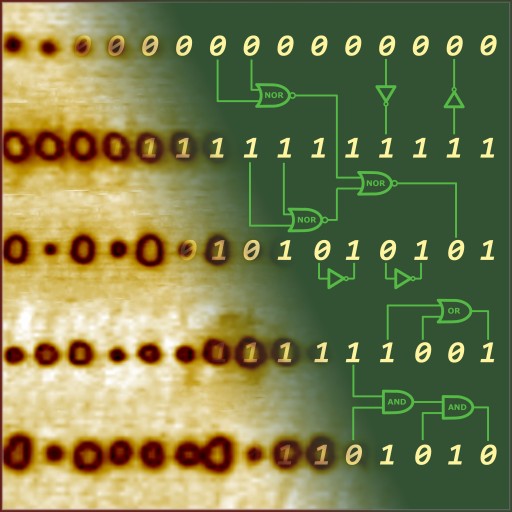Chaotic physics in ferroelectric materials may allow for brain-like computing
November 21, 2013
[+]
Unexpected behavior in ferroelectric materials explored by researchers at the Department of Energy’s Oak Ridge National Laboratory supports a new approach to information storage and processing called “memcomputing,” or memristor-based computing.
An illustration of memcomputing (credit: ORNL)
Ferroelectric materials are known for their ability to spontaneously switch polarization when an electric field is applied.
So using a scanning probe microscope, the ORNL-led team took advantage of this property to draw areas of switched polarization called domains on the surface of a ferroelectric material.
Unexpected chaotic patterns
To the researchers’ surprise, when written in dense arrays, the domains began forming complex and unpredictable patterns on the material’s surface.
“When we reduced the distance between domains, we started to see things that should have been completely impossible,” said ORNL’s Anton Ievlev, the first author on the paper published in Nature Physics.
[+]
“All of a sudden, when we tried to draw a domain, it wouldn’t form,
or it would form in an alternating pattern like a checkerboard.
A scanning probe microscope tip creating a domain with a ring of surface charge (credit: A. V. Ievlev et al/Nature Physics)
At first glance, it didn’t make any sense. We thought that when a domain forms, it forms. It shouldn’t be dependent on surrounding domains.”
After studying patterns of domain formation under varying conditions, the researchers realized the complex behavior could be explained through chaos theory.
One domain would suppress the creation of a second domain nearby but facilitate the formation of one farther away — a precondition of chaotic behavior, says ORNL’s Sergei Kalinin, who led the study.
Brain-like computing
Collaborator Yuriy Pershin of the University of South Carolina explains that the team’s system possesses key characteristics needed for memcomputing, an emergent computing paradigm in which information storage and processing occur on the same physical platform.
“Memcomputing is basically how the human brain operates: Neurons and their connections–synapses — can store and process information in the same location,” Pershin said.
“Potentially, the observed domain intermittency in ferroelectric materials could be used to create a novel generation of information processing devices, which store and process information at the same physical location,” Pershin explained to KurzweilAI.
“Specifically, we are thinking about binary logic devices in which two possible directions of ferroelectric domain polarization could be naturally used to encode two logic states: 0 and 1. While the conventional technology requires several transistors to realize a logic gate, ferroelectric materials offer a transistor-less approach to logic, in certain sense similar to information processing and storage in actual brains.
“Additionally, the discovered domain interaction effect offers some interesting opportunities in research. In particular, it can be used as a tool to study intriguing physics of complex dynamical systems showing, for example a controllable transition to chaos. Using our system, one can perform, for instance, bench top emulation of different systems otherwise not available experimentally.
As for realization in commercial products, Pershin said multiple steps are needed. “In particular, in our setup, ferroelectric domains are switched by a moving STM tip. An actual chip, however, should be designed without any moving parts. We do not know exactly how hard-wired electrodes will influence the interaction among ferroelectric domains, for example.”
What makes this research unique
A study in Nature (464, 873-876, 8 April 2010) also demonstrates binary logic operations with memory resistive devices. But in the Oak Ridge Lab work, ferroelectric materials sandwiched between metal electrodes are essentially capacitive structures with potentially smaller energy dissipations compared to resistive devices.
Another related paper is arXiv:1306.6133, introducing a memcapacitive dynamic computing random access memory.
“These previous works demonstrate or suggest logic operations with physically distinct memristive or memcapacitive devices, while our discovery shows that one can use the same physical piece of material to store multiple bits of information and perform logic — an important advance,” said Pershin.
Abstract of Nature Physics paper
Memristive materials and devices, which enable information storage and processing on one and the same physical platform, offer an alternative to conventional von Neumann computation architectures. Their continuous spectra of states with intricate field-history dependence give rise to complex dynamics, the spatial aspect of which has not been studied in detail yet. Here, we demonstrate that ferroelectric domain switching induced by a scanning probe microscopy tip exhibits rich pattern dynamics, including intermittency, quasiperiodicity and chaos. These effects are due to the interplay between tip-induced polarization switching and screening charge dynamics, and can be mapped onto the logistic map. Our findings may have implications for ferroelectric storage, nanostructure fabrication and transistor-less logic.
(¯`*• Global Source and/or more resources at http://goo.gl/zvSV7 │ www.Future-Observatory.blogspot.com and on LinkeIn Group's "Becoming Aware of the Futures" at http://goo.gl/8qKBbK │ @SciCzar │ Point of Contact: www.linkedin.com/in/AndresAgostini
 Washington
Washington